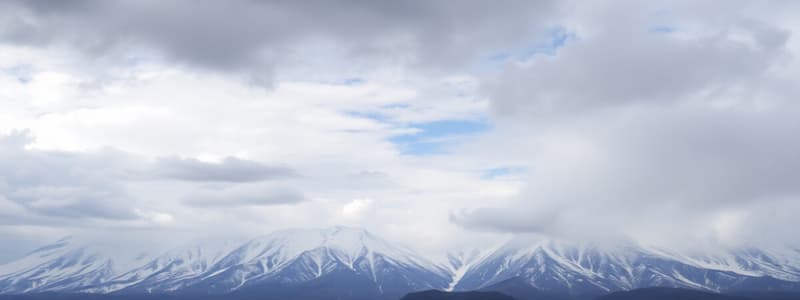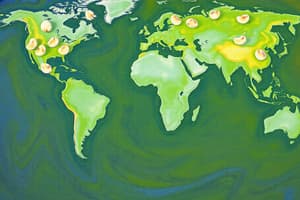Podcast
Questions and Answers
What is the approximate average temperature of the Earth with the greenhouse effect?
What is the approximate average temperature of the Earth with the greenhouse effect?
- 30 degrees Celsius
- 0 degrees Celsius
- 15 degrees Celsius (correct)
- -18 degrees Celsius
Ocean ice melting contributes to rising sea levels.
Ocean ice melting contributes to rising sea levels.
False (B)
Name one natural source of methane emissions.
Name one natural source of methane emissions.
Plants or animals
A feedback loop is a process that ______ on itself.
A feedback loop is a process that ______ on itself.
Match the following greenhouse gases with their primary anthropogenic (human-caused) sources:
Match the following greenhouse gases with their primary anthropogenic (human-caused) sources:
Which greenhouse gas is approximately 300 times more effective at trapping heat than carbon dioxide?
Which greenhouse gas is approximately 300 times more effective at trapping heat than carbon dioxide?
Cutting down forests can lead to a decrease in atmospheric carbon dioxide.
Cutting down forests can lead to a decrease in atmospheric carbon dioxide.
Name one way climate change has affected Canada's weather patterns.
Name one way climate change has affected Canada's weather patterns.
Which of the following best describes the relationship between climate and weather?
Which of the following best describes the relationship between climate and weather?
Ecoregions are primarily defined by temperature and precipitation patterns alone.
Ecoregions are primarily defined by temperature and precipitation patterns alone.
What is the primary source of energy on Earth?
What is the primary source of energy on Earth?
The greenhouse effect occurs when gases and clouds absorb _________ radiation.
The greenhouse effect occurs when gases and clouds absorb _________ radiation.
Match the following influencing factors with the aspects they affect:
Match the following influencing factors with the aspects they affect:
Which of the following best describes weather?
Which of the following best describes weather?
The climate of a region can change dramatically over a few years.
The climate of a region can change dramatically over a few years.
What are the two primary factors used to define climate zones?
What are the two primary factors used to define climate zones?
The sun's energy is the source of all energy on the planet, and approximately __% of the light is absorbed by the Earth.
The sun's energy is the source of all energy on the planet, and approximately __% of the light is absorbed by the Earth.
Match the following factors with their effect on climate:
Match the following factors with their effect on climate:
What is the effect of re-radiated energy on Earth's temperature?
What is the effect of re-radiated energy on Earth's temperature?
Methane is a more potent greenhouse gas than carbon dioxide.
Methane is a more potent greenhouse gas than carbon dioxide.
What are the two primary components of all greenhouse gases?
What are the two primary components of all greenhouse gases?
Before industrialization, the concentration of carbon dioxide in the atmosphere was approximately ______ ppm.
Before industrialization, the concentration of carbon dioxide in the atmosphere was approximately ______ ppm.
Match the following effects with their descriptions.
Match the following effects with their descriptions.
Which of the following is NOT considered an anthropogenic greenhouse gas?
Which of the following is NOT considered an anthropogenic greenhouse gas?
Melting ocean ice will significantly contribute to raising sea levels.
Melting ocean ice will significantly contribute to raising sea levels.
What has been observed regarding snow patterns in Canada due to climate change?
What has been observed regarding snow patterns in Canada due to climate change?
Flashcards
Weather
Weather
Current atmospheric conditions like temperature and precipitation.
Climate
Climate
Average weather in a region over 30 years.
Climate Zones
Climate Zones
Regions classified by temperature, precipitation, and ecosystems.
Greenhouse Effect
Greenhouse Effect
Signup and view all the flashcards
Factors Affecting Climate
Factors Affecting Climate
Signup and view all the flashcards
Greenhouse Gases
Greenhouse Gases
Signup and view all the flashcards
CO2
CO2
Signup and view all the flashcards
Water Vapor (H2O)
Water Vapor (H2O)
Signup and view all the flashcards
Methane (CH4)
Methane (CH4)
Signup and view all the flashcards
N2O (Dinitrogen monoxide)
N2O (Dinitrogen monoxide)
Signup and view all the flashcards
Evidence of Climate Change
Evidence of Climate Change
Signup and view all the flashcards
Anthropogenic Greenhouse Gases
Anthropogenic Greenhouse Gases
Signup and view all the flashcards
Ecoregions
Ecoregions
Signup and view all the flashcards
Suns Energy
Suns Energy
Signup and view all the flashcards
Climate Determinants
Climate Determinants
Signup and view all the flashcards
Greenhouse Effect Process
Greenhouse Effect Process
Signup and view all the flashcards
Climate Stability
Climate Stability
Signup and view all the flashcards
Greenhouse Effect Temperature
Greenhouse Effect Temperature
Signup and view all the flashcards
Carbon Dioxide (CO2)
Carbon Dioxide (CO2)
Signup and view all the flashcards
Dinitrogen Monoxide (N2O)
Dinitrogen Monoxide (N2O)
Signup and view all the flashcards
Rising Sea Levels
Rising Sea Levels
Signup and view all the flashcards
Melting Glaciers
Melting Glaciers
Signup and view all the flashcards
Changes in Precipitation
Changes in Precipitation
Signup and view all the flashcards
Change in Ecosystems
Change in Ecosystems
Signup and view all the flashcards
Study Notes
Weather vs. Climate
- Weather describes short-term atmospheric conditions (days to weeks), encompassing temperature, precipitation, humidity, and wind.
- Climate represents long-term average weather patterns (30 years or more) in a region. It determines the types of plants and animals that can survive there.
- Climate is what you expect; weather is what you get.
Climate Zones and Ecoregions
- Climate zones are determined by temperature, precipitation, and plant/animal communities.
- Ecoregions are broader, also considering human activities, soil types, and landforms, in addition to climate and organisms.
Factors Affecting Climate
- Proximity to large bodies of water moderates temperature.
- Latitude (distance from the equator) influences solar radiation intensity and temperature.
- Ocean and air currents distribute heat globally.
- Land formations and elevation impact local climates.
Solar Energy and the Greenhouse Effect
- The sun is Earth's primary energy source.
- About 70% of incoming solar radiation is absorbed by Earth's surface, warming it.
- The rest (30%) is reflected back into space.
- The absorbed energy is re-radiated as infrared radiation (heat).
- The greenhouse effect is a natural process where greenhouse gases and clouds absorb and re-radiate some of this infrared energy back towards Earth, maintaining a habitable temperature.
- Without the greenhouse effect, Earth's average temperature would be -18°C. With it, it's ~15°C.
Greenhouse Gases
- Greenhouse gases are atmospheric gases composed of two or more elements. Examples include CO2, CH4, N2O, and H2O.
- Carbon Dioxide (CO2): Represents 0.038% of the atmosphere.
- Pre-Industrial levels: 280 ppm.
- Current levels: 385 ppm.
- Oceans and vegetation act as carbon sinks.
- Water Vapor (H2O): Accounts for ~2/3 of the greenhouse effect.
- Methane (CH4): ~23 times more potent than CO2 as a greenhouse gas, primarily from natural sources and/or agriculture.
- Nitrous Oxide (N2O): ~300 times more potent than CO2 as a greenhouse gas, primarily from industry and agricultural sources.
Feedback Loops and Anthropogenic Impacts
- Feedback loops are processes where one change results in additional impacts that reinforce the initial condition.
- Anthropogenic greenhouse gases are those emitted by human activities.
Anthropogenic Greenhouse Gas Sources
- Carbon Dioxide (CO2): Primarily from burning fossil fuels (coal, oil, and natural gas) and deforestation.
- Methane (CH4): Associated with agriculture (livestock, rice paddies), coal mining, and landfills.
- Nitrous Oxide (N2O): Found in fertilizers and livestock feed.
Evidence of Climate Change
- Rising Temperatures: Global average temperatures have increased by 0.6 °C since 1970. Canada has seen a 1°C rise in the last 55 years; parts of the Yukon have experienced a substantially greater increase (2.5°C).
- Melting Glaciers and Ice Sheets: Glaciers are shrinking worldwide. Greenland's ice melt is accelerating.
- Rising Sea Levels: Melting land ice contributes significantly to rising sea levels, which threatens coastal areas. Ocean ice melt does not.
- Changes in Severe Weather: Increased frequency and intensity of heat waves, storms.
- Changes in Precipitation Patterns: Some regions experience more rainfall, others less, which can alter water resources and agriculture.
- Shifting Seasons: Earlier snowmelt, longer growing seasons, fewer cold days in some regions, and changes in timing of biological processes (migration, breeding).
- Changing Ecosystems: Species adapting to changing conditions by migrating or shifting ranges, affecting biodiversity.
Studying That Suits You
Use AI to generate personalized quizzes and flashcards to suit your learning preferences.




